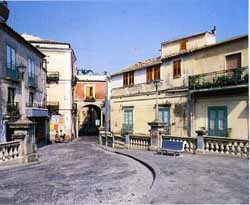
![]()
 |
Tourist's guide
Pro Loco of Caulonia
Presentation
![]() Guido Laganà
Guido Laganà
![]() Rinaldo D'Aquino
Rinaldo D'Aquino
![]() Map
of Caulonia
Map
of Caulonia
![]() How
to reach Caulonia
How
to reach Caulonia
![]() History
of Caulonia
History
of Caulonia
by
Antonio Nicaso
Churches
![]() Immacolata
Immacolata
![]() San
Leo
San
Leo
![]() Matrice
Matrice
![]() SS.
Rosario
SS.
Rosario
![]() The
byzantine church
The
byzantine church
![]() S.
Maria dei Minniti
S.
Maria dei Minniti
![]() The
byzantine fresco
The
byzantine fresco
![]() Madonna of Crochi
Madonna of Crochi
Monuments
and buildings
![]() The
Camillari tower
The
Camillari tower
![]() The norman castle
The norman castle
![]() Via Vincenzo Niutta
Via Vincenzo Niutta
![]() The hermitage of ...
The hermitage of ...
Nature
![]() The
Allaro river
The
Allaro river
![]() The
citrus fruit horchards
The
citrus fruit horchards
![]() The
sea
The
sea
On
the tracks of
tradition
![]() The
Caracolo
The
Caracolo
|
The
Norman castle The castle, which according to some, gave its name
to the town and whose founder is unknown, was the residence of
Malgeri d’Altavilla. Built in Norman style, it was subsequently
lived in by the Carafa family. Following the transfer to Naples
of the last Marquis Carlo Maria Carafa, the ancient fortress became
the premises of the ruler of the time until the earthquake which
shook Calabria in 1783 reduced it to terrible condition. “The
castle had an irregular external layout, partly surrounded by
a hand dug moat, fortified with a scarp and a counter-scarp, surrounded
by large towers and, in the front quarters, strengthened by stone
barriers and iron gates”. It also had soldiers and artillery men
who were able to resist even well organised enemies. The castle
was separated from the square by a hand dug trench: the connection
was made using a draw bridge. The castle, a real fortress with
moats, draw bridges, its curtains and ramparts and its parade
ground, had spacious courtyards and rear courtyards, a decorative
church, many rooms permitting the soldiers and servants to live
comfortably and huge store rooms for the conservation of food
supplies. |
The main road of the centre of Caulonia has been called after Vincenzo Niutta, famous magistrate, penniless minister in Cavour’s cabinet (1860) and senator of the kingdom (1861). He was born in Castelvetere in 1802 and he died at the age of 65 after having given lustre, honour and pride to all his co-citizens. |
|||||

Copyright © 2000 Caulonia 2000 per continuare a cambiare - All rights reserved

